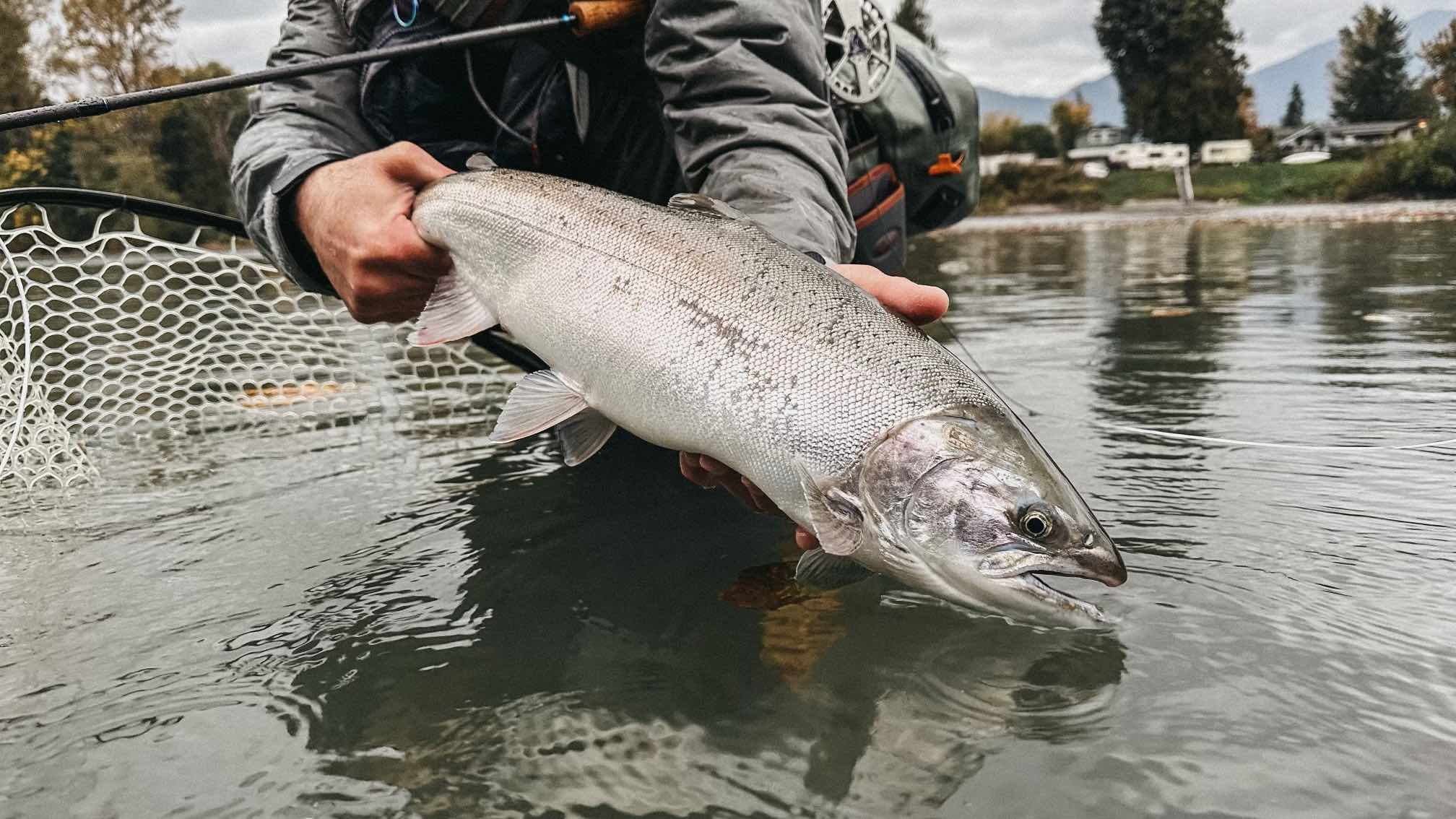
Local Waters
Fly Fishing in and around the Pacific Northwest
Lakes
Our shop is situated just a few short hours from the expansive Stillwater playground of interior British Columbia. Locally, we have several productive special regulations waters that afford an exceptional fly fishing experience.
North Cascades National Park
The Confluence Fly Shop is the closest full service fly shop to the west entrance of North Cascades National Park, which functions as a spectacular jumping off point for a wealth of fabulous fisheries. The 24-mile long Ross Lake is perhaps the crown jewel of the park, home to wild rainbow and large char that grow to robust proportions by dining on the lake’s abundant resident shiner population. Ross may be accessed via hiking in to the Ross Lake Resort and renting a small boat, portaging a canoe or kayak around Ross Dam, or driving in to the north end at Hozomeen via Hope, BC.
This fishery runs from July through October, offering breathtaking mountain views, a variety of wildlife, and memorable fishing. 5-6 weight rods, full sinking lines, and a respectable box crammed with shiner imitations will catch fish on the big lake. Numerous tributaries to Ross, like Big Beaver Creek and the upper Skagit River in BC provide outstanding backcountry fly fishing for cutthroat, rainbow, and in some cases, large bull trout.
Pass Lake
This year-round fly-only lake is situated on Fidalgo Island, just outside of Anacortes. The browns and rainbows planted in Pass are generally a bit larger and feed gluttonously on chironomids throughout the spring. A robust population of fathead minnows allows for some frenetic streamer fishing in the lowlight hours of early summer and fall.
Squalicum Lake
Another fly fishing-only lake, Squalicum Lake is just 20 minutes from downtown Bellingham, off Highway 542. At roughly 30 acres, it provides an intimate setting where one can escape to pursue cutthroat, triploid rainbows and tiger trout from a small watercraft or float tube. Though open year round, best fishing occurs in spring and fall. As a shallow lake, we’ll sometimes encounter hungry trout, rising eagerly to midge hatches by late February.
LAKES – WARMWATER
Though northwestern Washington is in-arguably considered a bastion for salmon, steelhead, trout, and char, the area warm water fly fishing opportunities are frequently overlooked.
Fazon Lake
Near Everson, Fazon hosts both largemouth bass and bluegill, which aggressively attack topwater presentations, damsel, dragon, and leech patterns.
Lake Whatcom
Just minutes from town, Lake Whatcom offers exceptional fly fishing for smallmouth bass, which may reach 4-5 lbs. Late spring and summer provide both surface action with popping and diving bugs, as well as casting or crawling streamers and crayfish patterns along the lake’s rocky bottom and heavily structured shoreline.
Terrell Lake
Terrell Lake, in northern Whatcom County, is matted with lilies and thick shoreline vegetation, boasting bragging size largemouth that ambush everything from bass leeches to popping and sliding bugs during the hot summer months. For bass, heavy 6-8 weight rods matched with floating lines account for much of the action, while a fast sink or streamer tip is a worthwhile companion for the Whatcom smallies. Panfish are an absolute riot on 2-4 weight rods matched with a floating line.
Rivers
Nooksack River
The Nooksack is comprised of a north, middle, and south fork which eventually convene to form the main stem near Deming, WA.
Glacially influenced, the north and middle forks may run gray-brown through much of the summer, while the south fork and the north above Nooksack Falls near Glacier generally flow clear. Opportunities for anadromous fish can be spotty, with some odd years hosting an opening for pink salmon, which begin returning in July, somewhat earlier than elsewhere in the Sound. Coho typically appear in good numbers from October through the end of the year, with Chum showing up in November and December.
Winter steelhead begin showing in December and provide a brief fishery before most of the river closes at the end of January. Bull trout are protected throughout the Nooksack however frequently encountered while fishing for salmon and steelhead, as are the many majestic bald eagles which winter along the cottonwood and alder lined banks of the river.
We rely on 7-8 weight switch and spey rods to cover water on the Nooksack when pursuing its large anadromous denizens. The numerous open tributaries to the forks, the North Fork above the falls and the upper reaches of the South Fork (which falls under fly fishing only regulations through the summer) offer outstanding high mountain trout and char fishing from July through October.
The new series of lightweight fiberglass rods from Echo and Redington are a simple joy to ply these waters with a handful of Stimulators and other high-floating attractor dries.
Sauk River
Though serving as a primary tributary to the Skagit, the Sauk’s tumbling, large boulder studded runs contrast starkly to the relative gentle nature of the Skagit below Marblemount. We mostly fish the Sauk in fall and winter for bull trout and steelhead.
Though present, salmon may not be targeted in the Sauk. Through much of the summer, a substantial portion of the Sauk runs turbid downstream of the glacial Suiattle and Whitechuck Rivers. We embrace the same techniques, flies, and presentations on the Sauk as used on the Skagit.
Skagit River
The Skagit is one of the most storied rivers in the Northwest, from the earliest days of steelhead fly angling pioneers like Ralph Wahl, Judge Ralph Olsen, and Al Knudsen to more contemporary anglers Harry Lemire, Dec Hogan, Ed Ward, and Jerry French.
Along its broad bars and cottonwood banks came advancements in modern two-handed rods and of course those short, thick spey heads that bear the river’s namesake. The Skagit is home to all five species of pacific salmon, winter and summer steelhead, coastal cutthroat, rainbow trout, bull trout, and mountain whitefish.
The Skagit fishes throughout the summer for char and rainbow trout, which we predominantly pursue with light spey and switch rods using a variety of lively streamers like our Willy Whitefish. In August, we begin to see sea run cutthroat appearing in the lower river, followed by an odd-year run of pink salmon approaching a million fish. Coho enter in waves from September through the end of the year and readily grab small flashy flies retrieved through backwaters and log-strewn sloughs. Chum arrive in early November, though in recent years, these runs have done poorly. Winter steelhead are available from December through the end of January when most of the river currently closes.
We opt for 7-8 weight spey rods for swinging the long, wide runs of the Skagit, which may be covered by floating the river or walking in. For salmon and cutthroat, we employ 6-8 weight single hand rods, floating, intermediate and light sink tip lines and a cast/retrieve presentation. Some of our best salmon/cutthroat fishing is in the lower river below Sedro Woolley, and is most effectively approached by boat.
Stillaguamish River
The NF Stillaguamish, or “Stilly,” remains one of the most literary steelhead rivers of our century, from early angler-writers Zane Grey and Roderick Haig-Brown to more recent authors Steve Raymond, Bob Arnold, and Ernest Schwiebert.
Though its wild steelhead have declined since those days, we still longingly wade the riffles and runs of the Stilly each summer, finding the odd hatchery and wild summer steelhead along the way. The river is open for fly fishing only when it opens in June through the last day of November.
We use 5-6 weight spey and switch rods, coupled with floating heads and sometimes light sink tips or poly leaders. We use a lot of classic summer steelhead patterns like the Purple Peril and Green Butt Skunk as well as Muddlers and skating flies between June and October. Sea run cutthroat arrive in August each year, and find us searching the root wads and brushy banks with 4-5 weight single hand rods and Reverse Spiders, Mickey Finns, or Rolled Muddlers.
Pink salmon show up in late August (in odd years), along with bright coho trickling in with the first freshets of fall. Salmon may be fished from the confluence of the North and South Forks in Arlington downstream. The North Fork is permanently closed to fishing for salmon.
Vedder River
The lower Vedder River near Chilliwack, BC is situated a mere 45 minutes from the Confluence, and for a river its size, often boasts absurd numbers of salmon and steelhead.
In odd years, late August and September find the river flush with pink salmon mixed in with hefty, annually returning fall chinook, known locally as white springs. October marks the beginning of a sizable coho return, which we’ll pursue in the many sloughs, canals and backwaters of the lower Vedder through November. Chum return in fishable numbers most years and these toothy, calico barred salmon will test your stoutest 8 weight. Toward the end of December, winter steelhead arrive in droves and provide a relatively consistent fishery through May for the fly angler, or until the river swells its banks with spring runoff.
With many of our Puget Sound steelhead rivers currently closed during the height of the spring season, we spend a fair amount of time north of border in pursuit of chrome. For pinks and coho, a 7 weight single hander with a floating and clear intermediate line work well. Chum and chinook are better matched with 8-10 weight rods and a variety of sink tips. As the river frequently runs very clear during salmon season, we generally fish fairly small, sparse patterns like California Neils and Rolled Muddlers with great success. Winter steelhead are best covered with a 7-8 weight spey rod for maximum efficiency and better line control sweeping the even, broad runs of the lower Vedder. We’ll fish anything from short Skagit heads, Scandi lines and poly leaders to mid-belly lines like the Nextcast Winter Authorities when venturing out for sunshine spring steelhead.
Saltwater - North Puget Sound
North Puget Sound
The North Sound offers a veritable smorgasbord of saltwater opportunities for the beach or boat-bound fly fisher. We fish the salt virtually year-round from Point Roberts to the southern tip of Whidbey Island in pursuit of sea run cutthroat, coho salmon, chinook salmon, pink salmon (odd years), sea run bull trout and the elusive saltwater steelhead.
5-6 weight rods are appropriate for cutthroat, pink salmon and smaller resident coho, while everything else is best targeted with a 7-8 weight outfit. Check out the beach line we designed for exceptional distance and handling for those tough to reach tide rips.
Most North Sound beaches come complete with stellar views of the islands and Olympic or Cascade Mountain Ranges. Time to get your salt on!
